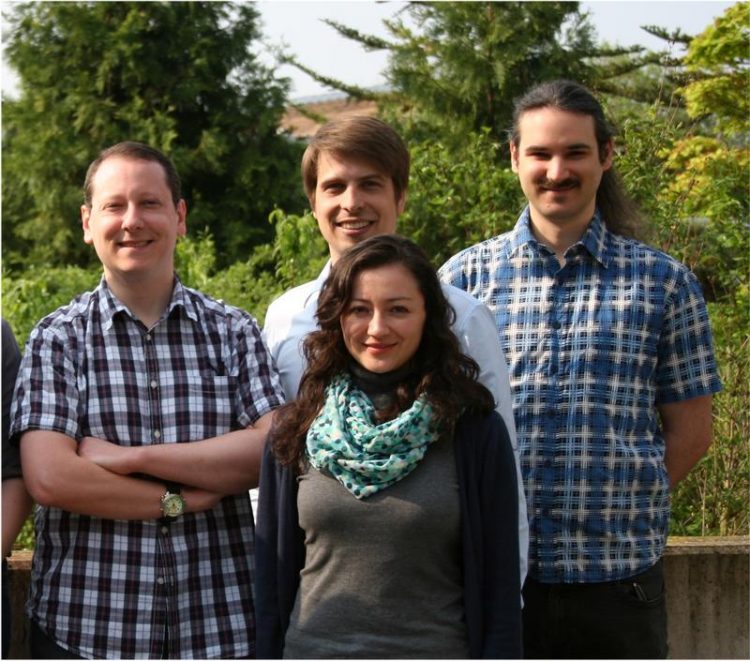A New Strategy to Analyze The Cellular World

From left to right: Prof. Dr. Silvio O. Rizzoli, Natalia Revelo, Dr. Dirk Kamin, Sven Truckenbrodt. AG Rizzoli
In the past two decades, super-resolution microscopy has been one of the fastest evolving fields through many technical improvements. However, the development of new labeling tools, probes and their biological application, is mostly lagging behind the technical capabilities.
Most recently, Prof. Silvio O. Rizzoli from the Cluster of Excellence and DFG- Research Center for Nanoscale Microscopy and Molecular Physiology of the Brain (CNMPB) has developed together with his team a new technique that expands the benefit of super- resolution microscopy to study biological questions.
This method contributes to understand on how cells renew, distribute and transport their molecular and subcellular components. The new technique was published on May 26th in the Journal of Cell Biology.
Original Publication:
Revelo NH, Kamin D, Truckenbrodt S, Wong AB, Reuter K, Reisinger E, Moser T, Rizzoli SO (2014) A new probe for super-resolution imaging of membranes elucidates trafficking pathways. J CELL BIOL, May 26; 205(4): 591-606.
All cells rely on the recycling of membranes via various pathways (secretion, uptake, and membrane turnover). Several types of cellular organelles such as the plasma membrane, the endoplasmic reticulum, the Golgi apparatus, endosomes and vesicles are involved in these processes.
However, it was difficult to identify the protein composition of the involved organelles since both, the membranes and the proteins of the same organelle need to be marked simultaneously. Here the main difficulty comes with the membrane probe, as almost all dyes that work excellent in live cell experiments are only poorly fixable and get “lost” during the antibody staining procedure.
The research team with first author Natalia Revelo therefore developed a membrane probe that overcomes this problem. The probe mCLING (membrane-binding fluorophore-Cysteine- Lysine-Palmitoyl Group) is a composition of a short polypeptide coupled to a membrane anchor and a fluorophore.
The study, recently published in the Journal of Cell Biology, shows that mCLING can be used to label the plasma membrane, and also to faithfully track specific organelles, which can be done in conjunction with fixation and immunostaining, in both cell culture and in tissue.
The utility of the mCLING probe could be characterized for various important biological model systems and already enabled the authors to answer long-lasting question in the field of membrane recycling. Moreover, mCLING imaging could also be extended to different processes.
For example, the structure and molecular organization of isolated organelles in vitro, or the arrangement of proteins on the membranes of various types of cells, can be easily tackled with mCLING. These efforts will be aided by the fact that mCLING can be optimized for any available super-resolution technique.
Prof. Dr. Silvio O. Rizzoli is head of the Department of Neuro- and Sensory Physiology at the University Medical Center Göttingen and member of the Göttingen Cluster of Excellence and DFG Research Center for Nanoscale Microscopy and Molecular Physiology of the Brain (CNMPB). His research focus includes the identification of molecular signal transduction processes between nerve cells.
Prof. Rizzoli applies super-resolution microscopy techniques to study the transport and function of intracellular vesicles in the synapses of nerve cells. Very recently, Prof. Rizzoli received for the second time with a prestigious funding award of the European Union for his excellent research proposal.
MORE INFORMATION
Prof. Dr. Silvio O. Rizzoli
University Medical Center Göttingen Department Neuro- & Sensory Physiology
c/o European Neuroscience Institute (ENI) Grisebachstraße 5, 37077 Göttingen
Phone 0551 / 39-33630, srizzol@gwdg.de
CNMPB – Center for Nanoscale Microscopy and Molecular Physiology of the Brain Cluster of Excellence 171 – DFG Research Center 103
Dr. Heike Conrad
Scientific Coordination, Press & Public Relations
Humboldtallee 23, 37073 Göttingen
Phone 0551 / 39-7065, heike.benecke@med.uni-goettingen.de
http://rizzoli-lab.de – Department Prof. Dr. Silvio O. Rizzoli
http://www.cnmpb.de – Cluster of Excellence and DFG Research Center for Nanoscale Microscopy and Molecular Physiology of the Brain
Media Contact
All latest news from the category: Life Sciences and Chemistry
Articles and reports from the Life Sciences and chemistry area deal with applied and basic research into modern biology, chemistry and human medicine.
Valuable information can be found on a range of life sciences fields including bacteriology, biochemistry, bionics, bioinformatics, biophysics, biotechnology, genetics, geobotany, human biology, marine biology, microbiology, molecular biology, cellular biology, zoology, bioinorganic chemistry, microchemistry and environmental chemistry.
Newest articles

Silicon Carbide Innovation Alliance to drive industrial-scale semiconductor work
Known for its ability to withstand extreme environments and high voltages, silicon carbide (SiC) is a semiconducting material made up of silicon and carbon atoms arranged into crystals that is…

New SPECT/CT technique shows impressive biomarker identification
…offers increased access for prostate cancer patients. A novel SPECT/CT acquisition method can accurately detect radiopharmaceutical biodistribution in a convenient manner for prostate cancer patients, opening the door for more…

How 3D printers can give robots a soft touch
Soft skin coverings and touch sensors have emerged as a promising feature for robots that are both safer and more intuitive for human interaction, but they are expensive and difficult…





















